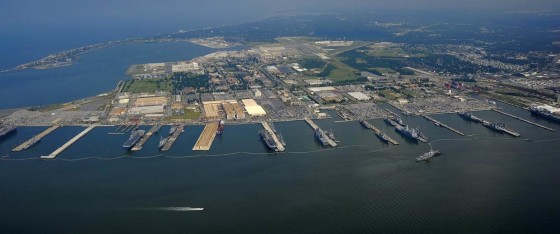
Squadron members rendering a salute to former shipmates. From left to right standing are Chief Larry Mondy (VA.), Sal Mantineo (DE.), Charles “Greek” Galowina (OH.), Joe Smilling (VA.), Vince Geraldi (N.J.), John Fugett (AL.).
Kneeling are Ken “Stoney” Field (ME.) and Bill Payne (VA.)
Members of VP–56, circa 1955–1960, met in Norfolk, Va. last October to rekindle memories, share sea stories, and pay tribute to shipmates both living and departed. Although few in number but high in spirit, the group toured Norfolk Naval Station, enjoyed refreshments in the hotel Ready Room and dined together at the Free Mason Tavern and Restaurant. On the Naval Station tour, two carriers (USS Abraham Lincoln and USS Dwight D. Eisenhower) were at berth along with several other attack ships. Security was tight and visitors were not allowed to leave the tour bus. Nevertheless, all were thrilled to see their old barracks and the seawall at Breezy Point. Very little remains of the hangars or sea plane ramps, but the group couldn’t help but envision the halcion days of flight lines, P5M’s, and the ebb and flow of a busy Naval Air Station.
Another highlight of the reunion was the sharing of letters sent by squadron members unable to attend. George Reed, Russ Farris, Amos Marck, to name a few, sent in vivid personal accounts of close calls and recollections of shipmates and memorable events, both good and bad! Russ Farris’s “A Seaplane Story” is one of them.
A Seaplane Story by Russ Farris
For each of my grandchildren’s birthdays I write them a story about the “olden days.” The following is an excerpt from a story I wrote for my grandson’s eighth birthday.
My best friends in VP-56 were Les Kuhn and Roy Whitson. Roy and I were on the same aircrew, and one morning we went out to preflight our P5M. I walked through the back of the airplane and up the ladder (stairs) to the “flight deck.” I didn’t know it, but a mechanic named John Belk had gotten on the airplane right after me. He climbed up a ladder (a real ladder) and opened a hatch between the wings. The hatch was right over the auxiliary power unit (APU). John crawled out of the hatch and walked across the wing to inspect one of the engines.
Roy climbed up the same ladder that John had climbed and checked the oil in the APU. When he saw that there was plenty of oil, Roy climbed down and walked forward, yelling up the ladder (stairs) to tell me that I could start the APU. I started it, and it blew up.
It was like a bomb. Parts of the APU flew through the side of the airplane, and through the sides of other airplanes hundreds of feet away. The burning oil from the APU was dripping down on the flares and practice depth charges that we had just put on the plane.
A huge column of fire and smoke was pouring out of the hatch that John Belk had just crawled through, so he was trapped on the top of the airplane. John was pretty cool. He walked out to the end of the wing, sat down, and lit a cigarette. Someone on the ground yelled at him to put the cigarette out, but John just laughed and kept on smoking. He didn’t think his cigarette was likely to set the plane on fire—since it was already on fire.
Roy and I grabbed small fire extinguishers and tried to put out the fire, but it was too big. Burning oil was dropping on us, burning holes in our clothes. The wooden outer parts of the flares were burning, but the magnesium in the flares had not ignited.
When our fire extinguishers were empty, Roy and I ran forward and started to climb out of the plane. Before we got out, a Parachute Rigger named Tony Palmieri grabbed a huge fire extinguisher and drug it up to the door of the plane. He climbed into the plane and turned on the large fire extinguisher. In a few minutes he put the fire out. John Belk put his cigarette out then.
The whole thing had lasted maybe five minutes from the time I tried to start the APU until the fire was put out, but Roy, John, Tony and I had inhaled a lot of smoke, and Roy and I had a lot of small burns. We were taken to the hospital, but we were back down at the VP–56 hangar in a couple of hours.
When we got back to the hangar, there were high–ranking officers and civilian engineers all over the place trying to figure out what happened. I thought I had done something wrong, but I was eventually cleared by Navy investigators.
I’m still in touch with Les Kuhn but I’ve lost contact with Roy Whitson. John Belk was a member of the Belk family that owns the department stores throughout the South. I am not absolutely sure that Tony Palmieri was the name of the parachute rigger that saved the plane and our butts. The story of why the APU blew up is a long one and not as interesting………………. Russ Farris



